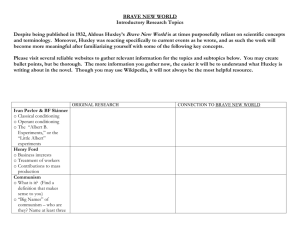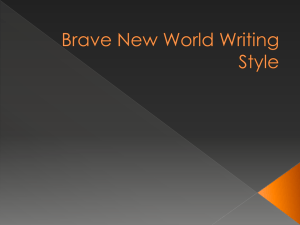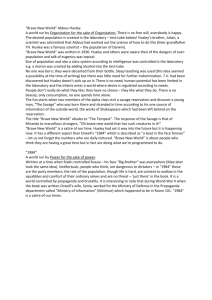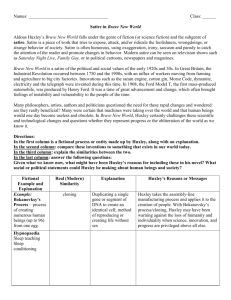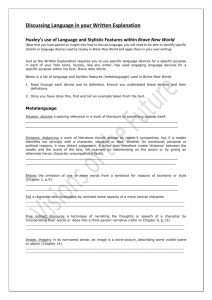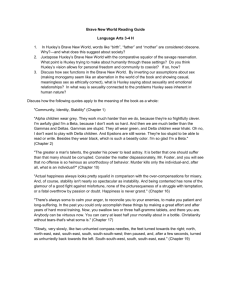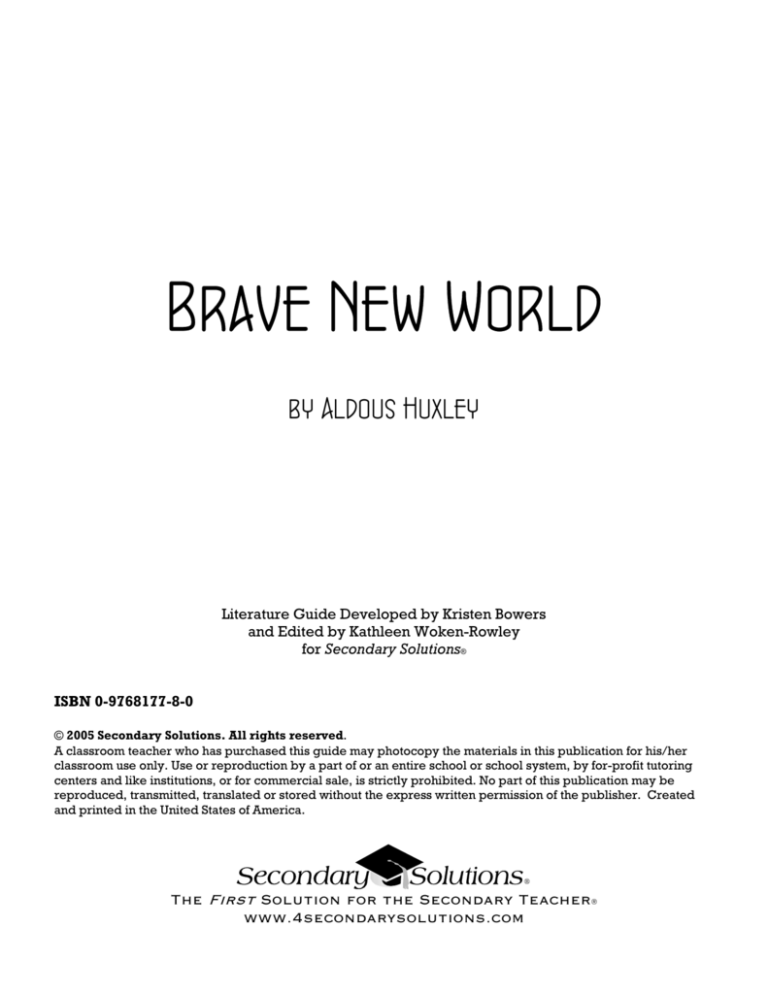
Name ________________________________
Period ________
Brave New World
by Aldous Huxley
Literature Guide Developed by Kristen Bowers
and Edited by Kathleen Woken-Rowley
for Secondary Solutions®
ISBN 0-9768177-8-0
© 2005 Secondary Solutions. All rights reserved.
A classroom teacher who has purchased this guide may photocopy the materials in this publication for his/her
classroom use only. Use or reproduction by a part of or an entire school or school system, by for-profit tutoring
centers and like institutions, or for commercial sale, is strictly prohibited. No part of this publication may be
reproduced, transmitted, translated or stored without the express written permission of the publisher. Created
and printed in the United States of America.
Secondary
Solutions
®
The First Solution for the Secondary Teacher®
www.4secondarysolutions.com
©2005 Secondary Solutions
1
Brave New World
Name ________________________________
Period ________
Brave New World
Complete Literature Guide
Table of Contents
About this Literature Guide
How to Use Our Literature Guides
Pre-Reading Activities and Preparation
Author Biography: Aldous Huxley
Standards Focus: Exploring Expository Writing
Anticipation/Reaction Guide
Standards Focus: Elements of the Novel
Standards Focus: Allusions and Terms
Vocabulary List
3
4
Comprehension Check: Foreword
Comprehension Check: Chapters 1-3
Standards Focus: Subgenres of Literature—Satire
Assessment Preparation: Base Words/Root Words/Affixes
Comprehension Check: Chapters 4-6
Standards Focus: Figurative Language
Assessment Preparation: Connotation/Denotation
Comprehension Check: Chapters 7-9
Standards Focus: Tone and Mood
Assessment Preparation: Context Clues
Quiz: Chapters 1-3
Quiz: Chapters 4-6
Quiz: Chapters 7-9
Part One Test: Chapters 1-9
12
13
14
16
17
18
20
21
22
24
25
26
27
28
Comprehension Check: Chapters 10-12
Standards Focus: Irony
Assessment Preparation: Base Words/Root Words/Affixes
Comprehension Check: Chapters 13-15
Standards Focus: Finding Supporting Quotations
Standards Focus: Using Supporting Quotations
Assessment Preparation: Context Clues
Comprehension Check: Chapters 16-18
Standards Focus: Symbolism
Assessment Preparation: Analogies
Quiz: Chapters 10-12
Quiz: Chapters 13-15
Quiz: Chapters 16-18
Anticipation/Reaction Guide Post-Reading Reflection
Just for Fun!: Brave New World Crossword Puzzle
Just for Fun!: Vocabulary Crossword Puzzle
Part Two Test: Chapters 10-18
Alternate Brave New World Final Test
Teacher Guide: Vocabulary Definitions
Summary of the Novel and Notes for the Teacher
Pre-Reading Ideas and Activities
Post-Reading Ideas and Alternative Assessment
Essay/Writing Ideas
Sample Project Rubric
Sample Response to Literature Rubric
Answer Key
31
32
34
35
36
38
39
40
41
42
43
44
45
46
47
48
49
52
56
57
59
60
61
62
63
65
5
6
7
8
9
11
Part One
Part Two
©2005 Secondary Solutions
2
Brave New World
Name ________________________________
Standards Focus: Subgenres of Literature—Satire
Period ________
Many students are familiar with the different genres, or categories, of literature—fiction, nonfiction,
poetry, autobiography, biography, plays, newspaper, folk tales—to name a few. However, there are
often many subgenres of literature within these genres. For example, under the broad genre of plays,
there are the subgenres of comedy, tragedy and history. Under the genre of mystery, there are the
subgenres of thriller, detective, historical, romantic, and suspense.
Brave New World falls under the genre of fiction (or science fiction) and the subgenre of satire. Satire is a
piece of work that tries to expose, attack and/or ridicule the foolishness, wrongdoings, or strange
behavior of society. Satire is often humorous, using exaggeration, irony, sarcasm and parody to catch the
attention of the reader and promote changes in behavior. Modern satire can be seen on television shows
such as Saturday Night Live, The Simpsons, or in political cartoons in newspapers and magazines.
Brave New World is a satire of the political and social values of the early 1920s and 30s. In Great Britain,
the Industrial Revolution occurred between 1750 and the 1900s, with an influx of workers moving from
farming and agriculture to big city factories. Innovations such as the steam engine, cotton gin, Morse
Code, dynamite, electricity and the telegraph were invented during this time. In 1903 the Ford Model T,
the first mass-produced automobile, was produced by Henry Ford. It was a time of great advancement
and change, which often brought feelings of instability and vulnerability to the people of the time.
Many philosophers, artists, authors and politicians questioned the need for these rapid changes and
wondered: are they really beneficial? Many were certain that machines were taking over the world, and
that human beings would one day become useless and obsolete. In Brave New World, Huxley certainly
challenges these scientific and technological changes and questions whether they represent progress or
the obliteration of the world as we know it.
Directions: In the first column is a fictional process or entity made up by Huxley, along with an explanation.
In the second column, compare these inventions to something that exists in our world today. Then, in the
third column, explain the similarities. In the last column, answer the following questions: 1) Knowing what
we know today, what might have been Huxley’s reasons for including these in his novel? 2) What social or
political statements could Huxley be making about human beings and society? An example has been done
for you.
Fictional
Example and
Explanation
Example:
Bokanovsky’s
Process/
Bokanovsky
Twins-process of
creating
numerous human
beings (up to 96)
from one egg
Real (Modern)
Similarity
cloning
©2005 Secondary Solutions
Explanation
Huxley’s Reasons/Statements/Message
duplicating a
single gene or
segment of DNA
to create an
identical cell
(Dolly the
sheep)
Huxley didn’t realize it, but this was a real
possibility—and in the 20th Century we have
achieved it. Huxley may have been warning
of the loss of individuality and identity for
the sake of science.
14
Brave New World
Name ________________________________
Standards Focus: Subgenres of Literature—Satire
Fictional
Example and
Explanation
1) hypnopaedia:
sleep teaching
Real (Modern)
Similarity
Explanation
Period ________
Huxley’s Reasons/Statements/Message
2) Malthusian
belt:
contraceptive
belt
3) soma: legal
drug with no side
effects or social
stigma
4) Social
Conditioning:
teaching people
to appreciate and
fully accept their
position in life
©2005 Secondary Solutions
15
Brave New World

